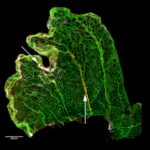‘Human accelerated regions’: How they make our brains uniquely human

Starting when humans diverged from chimpanzees some 5 to 6 million years ago, we’ve evolved in our uniquely human fashion thanks to changes in our genome. And certain parts of the human genome, known as human accelerated regions or HARs, have evolved especially rapidly.
Intriguing new work led by Christopher Walsh, MD, PhD, of Boston Children’s Hospital provides the most thorough evaluation of HARs to date. The findings, published in the October issue of Neuron, indicate that nearly half of all HARs are active in brain cells, acting as enhancers that boost gene expression, or activity. HARs may well have endowed us with our quintessentially human qualities — like our cognitive, creative, and artistic abilities.
“Probably one of the most interesting questions in neuroscience is, ‘What makes us human?’” says Walsh, who also directs the Allen Discovery Center for Human Brain Evolution at Boston Children’s. “Looking at human accelerated regions provided us with a very targeted way to investigate that question from a genetic perspective.”
Putting HARs through their paces
The researchers put more than 3,100 previously identified HARs through comprehensive testing, combining an enhanced “barcoding” approach developed in the Walsh lab, RNA sequencing, and other techniques. For these studies, they inserted different HARs and corresponding chimpanzee DNA into developing brain cells from mice and humans at different stages of maturation. For comparison, they also looked at other cell types. They then looked for differences in gene expression.
“We knew going in that many HARs were likely to function as regulators of gene expression in the brain, but we knew very little about which cell types in the brain they worked in, where, or at what time in the human lifespan,” says Ellen DeGennaro, a PhD candidate in the Walsh lab and a co-first author on the study. “Our goal was to fill in these gaps of knowledge, so that we and other researchers could take the most important ‘brain HARs’ and perform deeper tests of their evolutionary function.”

A uniquely human gene
The initial round of studies produced a short list of some 210 HARs that specifically enhanced gene activity in fetal neurons across multiple kinds of tests. Delving further, the team found one gene of particular interest, PPP1R17, that is regulated by several HARs. Comparing different species, they found that the gene was more active in the developing cerebral cortex of humans versus rhesus macaques. They did not detect activity in non-primates (mice or ferrets).
Further experiments suggested that PPP1R17 has a role in regulating the maturation of neurons, showing that it slowed the pace of cell division. The researchers believe this has contributed to humans’ larger brains. It might even help explain the extended period of brain development we undergo as compared with other primates, resulting in human newborns being relatively helpless and requiring extended care from their mothers.
Explaining neurobehavioral conditions?
HARs may also be important in neurodevelopmental disorders. In a 2016 study of HARs, Walsh and colleagues found that mutations in certain HARs were more common in children with autism spectrum disorder.
“The disruption of HARs in some human cognitive and social disabilities suggests that they are important for normal cognitive function in today’s world, as well as shaping the abilities of our ancestors in millennia past,” says Walsh. “Surprisingly, understanding cognitive differences in children today also helps us look into our ancient history.”
Kelly Girskis of Boston Children’s and Andrew Stergachis of the University of Washington were co-first authors on the paper with DeGennaro. The work was supported by the National Institutes of Health and the Allen Discovery Center program, a Paul G. Allen Frontiers Group advised program of the Paul G. Allen Family Foundation.
Learn more about research at Boston Children’s Hospital
Related Posts :
-

A 'pump' gene's surprising role in early brain formation
In polymicrogyria, the cortex of the brain has many irregular, small folds (gyria) and disorganization of its layers. Many affected ...
-

New technique yields potential treatment for a common cause of autism
Since 2008, we have known that the 16p11.2 chromosomal region is linked with autism spectrum disorder (ASD). Now, researchers from Boston ...
-

‘Mosaic’ gene mutations could explain some cases of autism
The causes of autism remain mysterious. Scientists have linked autism spectrum disorder to a long list of genes, but most ...
-

Exploring an unsung part of the brain: the choroid plexus
If you’ve never heard of the choroid plexus, you’re not alone. In fact, few neuroscientists know much about ...





